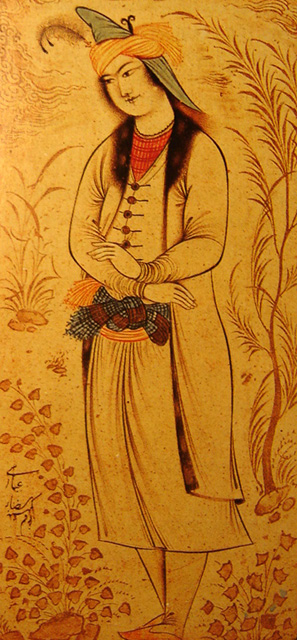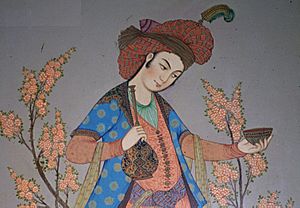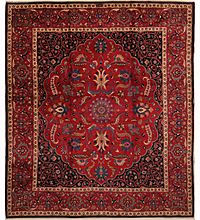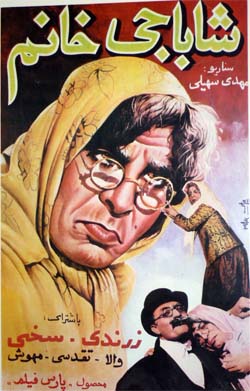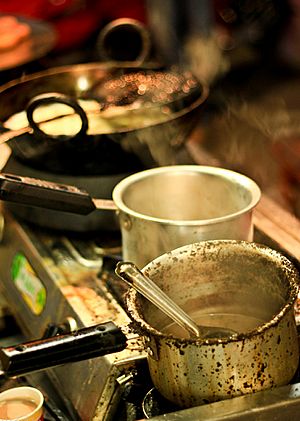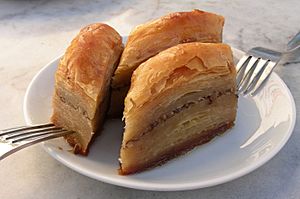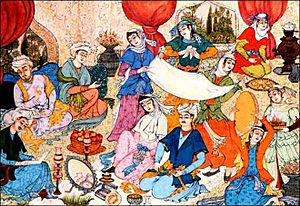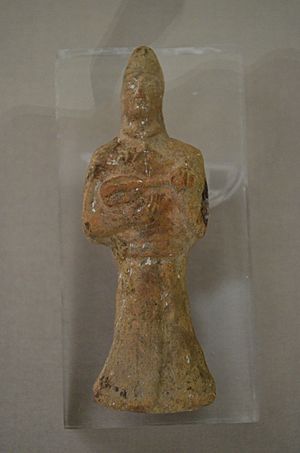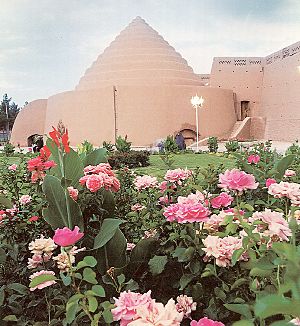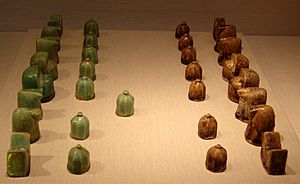Culture of Iran facts for kids
The culture of Iran or culture of Persia is one of the oldest in the world. Owing to its dominant geo-political position and culture in the world, Iran has directly influenced cultures and peoples as far away as Italy, Macedonia, and Greece to the West, Russia to the North, the Arabian Peninsula to the South, and South and East Asia to the East.
Thus an eclectic cultural elasticity has been said to be one of the key defining characteristics of the Persian spirit and a clue to its historical longevity. Furthermore, Iran's culture has manifested itself in several facets throughout the history of Iran as well as the Caucasus, Central Asia, Anatolia, and Mesopotamia.
Contents
Art
Iran has one of the richest art heritages in world history and encompasses many disciplines including architecture, painting, weaving, pottery, calligraphy, metalworking and stonemasonry. There is also a very vibrant Iranian modern and contemporary art scene.
Iranian art has gone through numerous phases. The Islamic era brought drastic changes to the styles and practice of the arts.
Religion in Iran
Zoroastrianism was the national faith of Iran for more than a millennium before the Arab conquest. It has had an immense influence on Iranian philosophy, culture and art after the people of Iran converted to Islam.
Today of the 98% of Muslims living in Iran, around 89% are Shi’a and only around 9% are Sunni.
Persian rugs
In Iran, Persian rugs have always been a vital part of the Persian culture.
Iranians were some of the first people in history to weave carpets. First deriving from the notion of basic need, the Persian rug started out as a simple/pure weave of fabric that helped nomadic people living in ancient Iran stay warm from the cold, damp ground. As time progressed, the complexity and beauty of rugs increased to a point where rugs are now bought as decorative pieces. Because of the long history of fine silk and wool rug weaving in Iran, Persian rugs are world-renowned as some of the most beautiful, intricately designed rugs available. Around various places in Iran, rugs seem to be some of the most prized possessions of the local people. Iran currently produces more rugs and carpets than all other countries in the world put together.
Modern culture
Cinema
With 300 international awards in the past 10 years, Iranian films continue to be celebrated worldwide.
Contemporary art
There is a resurgence of interest in Iranian contemporary artists and in artists from the larger Iranian diaspora.
Music
The music of Persia dates to before the days of Barbod in the royal Sassanid courts. This is where many music cultures trace their distant origins.
Architecture
Traditional tea-houses
There are countless numbers of traditional tea-houses (chai khooneh) throughout Iran, and each province features its own unique cultural presentation of this ancient tradition. However, there are certain traits which are common to all tea-houses, especially the most visible aspects, strong chai (tea) and the ever-present ghalyan hookah. Almost all tea-houses serve baqleh, steam boiled fava beans (in the pod), served with salt and vinegar, as well as a variety of desserts and pastries. Many tea-houses also serve full meals, typically a variety of kebabs, as well as regional specialties.
Persian gardens
The Persian garden was designed as a reflection of paradise on earth; the word "garden" itself coming from Persian roots. The special place of the garden in the Iranian heart can be seen in their architecture, in the ruins of Iran, and in their paintings.
Cuisine
Cuisine in Iran is considered to be one of the most ancient forms of cuisine around the world. Bread is arguably the most important food in Iran, with a large variety of different bread, some of the most popular of which include: nan and hamir, which are baked in large clay ovens (also called "tenurs"). In Iranian cuisine, there are many dishes that are made from dairy products. One of the most popular of which includes yoghurt ("mast")—which has a specific fermentation process that is widely put to use amongst most Iranians.
In addition, mast is used to make soup and is vital in the production of oil. In addition to these dairy products, Iranian cuisine involves a lot of dishes cooked from rice. Some popular rice dishes include boiled rice with a variety of ingredients such as meats, vegetables, and seasonings ("plov") including dishes like chelo-horesh, shish kebab with rice, chelo-kebab, rice with lamb, meatballs with rice, and kofte (plain boiled rice).
Iranian cuisine is famous for its sweets. One of the most famous of which includes "baklava" with almonds, cardamom, and egg yolks. Iranian sweets typically involve the use of honey, cinnamon, lime juice, and sprouted wheat grain. One very popular dessert drink in Iran, "sherbet sharbat-portagal", is made from a mixture of orange peel and orange juice boiled in thin sugar syrup and diluted with rose water. Just like the people of many Middle Eastern countries the most preferred drink of the people of Iran is tea (without milk) or "kakhve-khana".
Sports
The game of Polo originated with Iranian tribes in ancient times and was regularly seen throughout the country until the revolution of 1979 where it became associated with the monarchy. It continues to be played, but only in rural areas and discreetly. Recently, as of 2005, it has been acquiring an increasingly higher profile. In March 2006, there was a highly publicised tournament and all significant matches are now televised.
Traditional holidays/celebrations
Iranians celebrate the following days based on a solar calendar, in addition to important religious days of Islamic and Shia calendars, which are based on a lunar calendar.
- Nowruz (Iranian New Year) - Starts from 21 March
- Sizdah be dar (Nature Day)
- Jashn-e-Tirgan (Water Festival)
- Jashn-e-Sadeh (Fire Festival)
- Jashn-e-Mehregan (Autumn Festival)
- Shab-e-Yalda (Winter Feast)
- Charshanbeh Suri
Contributions to humanity in ancient history
From the humble brick, to the windmill, Persians have mixed creativity with art and offered the world numerous contributions. What follows is a list of just a few examples of the cultural contributions of Greater Iran.
- (10,000 BC) - Earliest known domestication of the goat.
- (6000 BC) - The modern brick. Some of the oldest bricks found to date are Persian, from c. 6000 BC.
- (5000 BC) - Invention of wine. Discovery made by University of Pennsylvania excavations at Hajji Firuz Tepe in northwestern Iran.
- (5000 BC) - Invention of the Tar (lute), which led to the development of the guitar.
- (3000 BC) - The ziggurat. The Sialk ziggurat, according to the Cultural Heritage Organization of Iran, predates that of Ur or any other of Mesopotamia's 34 ziggurats.
- (3000 BC) - A game resembling backgammon appears in the east of Iran.
- (1400 BC - 600 BC) - Zoroastrianism: where the first prophet of a monotheistic faith arose according to some scholars, claiming Zoroastrianism as being "the oldest of the revealed credal religions, which has probably had more influence on mankind directly or indirectly, more than any other faith".
- (576 BC - 529 BC) - The Cyrus Cylinder: The world's first charter of human rights.
- (576 BC - 529 BC) - Under the rule of Cyrus the Great, Cyrus frees the Jews from Babylonian captivity. See Cyrus in the Judeo-Christian tradition.
- (521 BC) - The game of Polo.
- (500 BC) - First Banking System of the World, at the time of the Achaemenid, establishment of Governmental Banks to help farmers at the time of drought, floods, and other natural disasters in form of loans and forgiveness loans to restart their farms and husbandries. These Governmental Banks were effective in different forms until the end of Sassanian Empire before invasion of Arabs to Persia.
- (500 BC) - The word Check has a Persian root in old Persian language. The use of this document as a check was in use from Achaemenid time to the end of Sassanian Empire. The word of [Bonchaq, or Bonchagh] in modern Persian language is new version of old Avestan and Pahlavi language "Check". In Persian it means a document which resembles money value for gold, silver and property. By law people were able to buy and sell these documents or exchange them.
- (500 BC) - World's oldest staple.
- (500 BC) - The first taxation system (under the Achaemenid Empire).
- (500 BC) - "Royal Road" - the first courier post.
- (500 BC) - Source for introduction of the domesticated chicken into Europe.
- (500 BC) - First cultivation of spinach.
- (400 BC) - Yakhchals, ancient refrigerators. (See picture above)
- (400 BC) - Ice cream.
- (250 BC) - Original excavation of a Suez Canal, begun under Darius, completed under the Ptolemies.
- (50 AD) - Peaches, a fruit of Chinese origin, were introduced to the west through Persia, as indicated by their Latin scientific name, Prunus persica, from which (by way of the French) we have the English word "peach."
- (271 AD) - Academy of Gundishapur - The first hospital.
- (700 AD) - The cookie.
- (700 AD) - The windmill.
- (864 AD - 930 AD) - First systematic use of alcohol in Medicine: Rhazes.
- (1000 AD) - Tulips were first cultivated in medieval Persia.
- (1000 AD) - Introduction of paper to the west.
- (935 AD - 1020 AD) - Ferdowsi writes the Shahnama (Book of Kings) that resulted in the revival of Iranian culture and the expansion of the Iranian cultural sphere.
- (980 AD - 1037 AD) - Avicenna, a physician, writes The Canon of Medicine one of the foundational manuals in the history of modern medicine.
- (1048 AD - 1131 AD) - Khayyam, one of the greatest polymaths of all time, presents a theory of heliocentricity to his peers. His contributions to laying the foundations of algebra are also noteworthy.
- (1207 AD - 1273 AD) - Rumi writes poetry and in 1997, the translations were best-sellers in the United States.
- Algebra and Trigonometry: Numerous Iranians were directly responsible for the establishment of Algebra, the advancement of Medicine and Chemistry, and the discovery of Trigonometry.
- Qanat, subterranean aqueducts.
- Wind catchers, ancient air residential conditioning.
Images for kids
-
Intricate stone art of Persepolis
-
Shah Mosque, Isfahan
See also
 In Spanish: Cultura de Irán para niños
In Spanish: Cultura de Irán para niños


